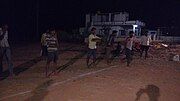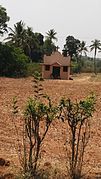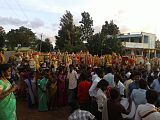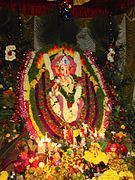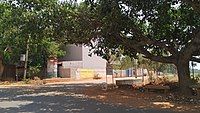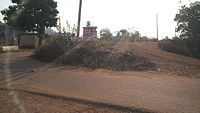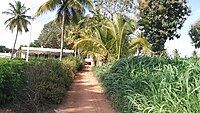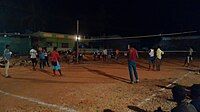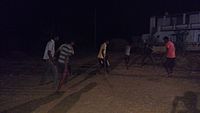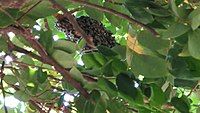Nadipinayakanahalli
Nadipinayakanahalli | |
|---|---|
Village | |
| Coordinates: 13°18′07″N 77°51′53″E / 13.302050°N 77.864700°E | |
| Country | |
| State | Karnataka |
| District | Chikkaballapura |
| Established | 19th century (1830–1880) |
| Founded by | Unknown |
| Named for | Unknown |
| Government | |
| • Type | Democracy |
| • Body | Grama Panchayath |
| Area | |
• Total | 6−8 km2 (3 sq mi) |
| Elevation | 893 m (2,930 ft) |
| Population (2012) | |
• Total | 1,000−1,200 |
| • Density | 900/km2 (2,000/sq mi) |
| Languages | |
| • Official | Kannada |
| Time zone | UTC+5:30 (IST) |
| PIN | 562102 |
| Telephone code | 08158 |
| Vehicle registration | KA 40 |
Nadipinayakanahalli[1] is a Kannada-speaking village in Sidlaghatta Taluk, Chikkaballapur District. It comes under Nagamangala gram panchayat in Chikkaballapura district.
Geography
[edit]Nadipinayakanahalli is located 27 km south-east of Chikballapur, the district's headquarters, and 64 km from the state capital Bangalore. Surrounding cities and towns include Vijayapura to the west, Hoskote and Devanahalli to the south, and Sidlaghatta and Chintamani to the north.[2][3]
Demographics
[edit]The population of the village ranges from 1000 to 1200.[4] Most of the village inhabitants are farmers and are lower middle class. The literacy rate is above 80% thanks to the successful implementation of schemes such as Sarva Shiksha Abhiyan and illiteracy eradication schemes. Most of the village children attend Navodaya school, a government-run school located in the village. Others attend schools in Jangamakote Cross, near Jangamakote, and Vijayapura.
Occupation
[edit]Sericulture and agriculture are the two major occupations, with 90% of the working population rearing silkworms. Men in this area are famously hard working.[citation needed] Ragi is the main crop during the rainy season. Edible fruits and vegetables such as beetroot, carrot, cabbage, grapes, potato, mango, banana, cucumber, watermelon, cashew nuts, papaya, jack fruit, and jambu are also farmed. Mulberry plants are prolific in the village.
Water is scarce in Nadipinayakanahalli. Village inhabitants have invested in bore wells, and agricultural land has been converted to drought land because of the scarcity of water. Drip irrigation is commonly used to water plants.
The lake at the end of the village covers an area of approximately 150 to 250 acres. The lake partially fills during the rainy season when rain water is collected, but is drained within days. Desperate farmers cultivate the land during the rainy season to produce ragi. This practice is strictly prohibited by the state government.[citation needed]


Domestic life
[edit]Dairy farming (cattle rearing) is widely practiced and is a secondary source of income for average middle-class families. Two non-indigenous breeds, Holstein Frisian and Jersey, are favored because of their high production of milk. Indigenous (desi) cows like hallikar are disappearing as farmers rely on tractors for the cultivation of the land. The number of hallikar cows in the village has fallen from several hundred to under ten, due to lack of food. Cows are worshiped yearly during the Sankranthi festival.

Dogs play a prominent role in Nadipinayakanahalli. Dog ownership is high because of the belief that dogs are loving, affectionate and protective. They often accompany villagers when gardening and during routine walks.
There are rare encounters between humans and snakes. Cobras sometimes enter houses looking for prey such as rats, frogs and hens. Snake bites are often reported but are successfully treated at nearby hospitals.
Transportation
[edit]Every family owns one or more vehicle, such as a bike, tractor or car. There is excellent road infrastructure. In addition to vehicle parking, cows, buffalo and goats are frequently tethered on the road frontage outside a home.
Forest Area
[edit]The village is surrounded by dry forest towards the east. Eucalyptus, tamarind, sandalwood, teak and other trees are grown, as well as bamboo. Forest guards patrol the boundary regularly to prevent villagers from taking trees. Tree poles from eucalyptus are in demand as building material, leading to the possibility of illegal logging. There is a forest reserve where wild animals are abundant. Forestry activities contribute to ground water level depletion.[citation needed]

Sports
[edit]Cricket is popular in the village, with volleyball, and kabbadi also played occasionally.
Village sights
[edit]There are several temples near the village, including temples to Hanuman, Gangamma, and Muneeswarar. Kaivara, the popular hill station is 10 km away via the forest road. There is a cave that was damaged by a landslide but is still visible. The Hanuman temple is also in poor condition.
Culture
[edit]Cultural events are held during Ganesh Chaturthi and Sankranthi. Fairs (ಜಾತ್ರೆ) are held every two years. Some villagers travel to religious destinations such as Tirupathi, Dharmasthala and the Nandi Hills.
Environmental issues
[edit]Depletion of ground water is a major challenge, with most bore wells having run dry. Rainfall is extremely low at 20 cm – 30 cm annually. A major reason for the water depletion is the absence of micro-irrigation systems and the intensive farming that occurred during the 1980s and 1990s. The state government has initiated the Gundia river/Yettinahole Project to bring new water to the district by diverting the west-flowing Nethravathi river to Chikkaballapura and Kolar, but the project has been delayed due to ecological concerns and protests.[5]


Criticisms
[edit]The village has a poor reputation for dirty caste politics and factionalism, and fights between villagers are frequent.[citation needed]
Gallery
[edit]-
Nadipinayakanahalli entrance gate
-
ಹಳ್ಳಿಯ ರಸ್ತೆ
-
ಅಶ್ವಥ್ ಕಟ್ಟೆ
-
villager climbing Coconut tree
-
Dry lake view from Bridge
-
Dry field of lake
-
ರಾಗಿ ಮರ
-
Sub way Road to Yennanguru village
-
Lake view from bridge
-
ಶಿವರಾತ್ರಿ ಹಬ್ಬದ ಸಮಯದಲ್ಲಿ ಕಬಡ್ಡಿ ಆಡುವ ಹಳ್ಳಿಗರು
-
ಗುಹೆಯ ತೆರೆದ ನೋಟ
-
ತೆಂಗಿನ ಮರ ಏರುತ್ತಿರುವ ಯುವಕ
-
ವಾಲಿಬಾಲ್ ಆಡುತ್ತಿರುವ ಯುವಕರು
-
ಕಬಡ್ಡಿ ಆಟದಲ್ಲಿ ರೋಚಕ ಕ್ಷಣ
-
ಕಬಡ್ಡಿ ಆಡುತ್ತಿರುವ ಯುವಕರು
-
ವಾಲಿಬಾಲ್ ಆಟದ ಮೇಲಿನ ನೋಟ
-
Mango plantation
-
ಜೇನು ಗೂಡು
References
[edit]- ^ Rice, Benjamin Lewis (1894) (1894). "Nadipinayakanahalli name citiation". archive.org. B. Lewis Rice, Director of Archaeological Researches in Mysore. Retrieved 10 March 2016.
{{cite web}}: CS1 maint: numeric names: authors list (link) - ^ Gowda, Rakshith. "Nadipinayakanahalli". villageinfo. admin. Retrieved 26 February 2016.
- ^ Gowda, Sonne. "Allindiafacts". allindiafacts.com. admin [at] allindiafacts.com. Retrieved 26 February 2016.
- ^ Gowda, Dileep. "Census2011". /www.census2011.co.in. Retrieved 26 February 2016.
- ^ Moudgal, Sandeep (29 October 2013). "Fate of Gundia hydel power project hangs in balance". Deccan Herald. Retrieved 20 September 2019.





